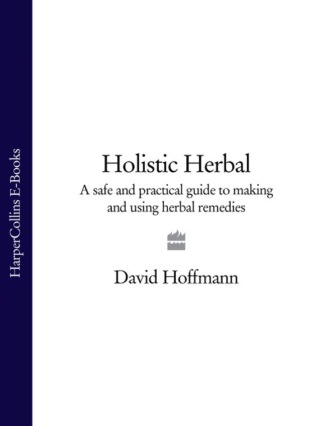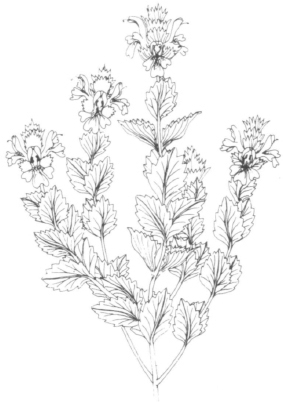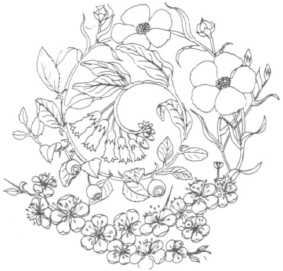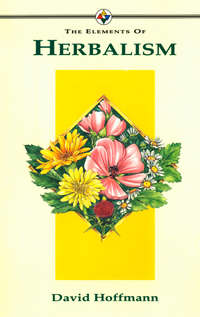
Полная версия
Holistic Herbal: A Safe and Practical Guide to Making and Using Herbal Remedies


HOLISTIC HERBAL
A Safe and Practical Guide to Making and Using Herbal Remedies
DAVID HOFFMANN

Dedication
To Lolo, for now and always
Contents
Cover
Title Page
Dedication
Preface
Introduction to the Third Edition
How to use this Book
A Herbal Medicine Chest for the Home
The Holistic Approach
Gaia—the Living Earth
Herbs and Ecology
Ecosystems and the Biosphere
Herbs in Healing
Homeostasis
Self-Healing
The Circulatory System
Prevention of Circulatory Disease
Herbs for the Circulatory System
Patterns of Disease
The Lymphatic System
The Respiratory System
Prevention of Respiratory Disease
Herbs for the Respiratory System
Patterns of Disease of the Respiratory System
Ears, Nose, Throat & Eyes
Herbs for Ears, Nose, Throat and Eyes
The Ears
The Nose
The Throat
The Eyes
The Digestive System
Prevention of Disease
Herbs for the Digestive System
Patterns of Digestive Disease
The Mouth
The Stomach
The Small Intestine
The Large Intestine
Liver and Gall-Bladder
The Nervous System
Herbs for the Nervous System
Patterns of Dis-ease of the Nervous System
The Skin
Herbs for the Skin
Patterns of Skin Diseases
Internal Causes
Internal Reactions to External Causes
External Causes
The Muscular & Skeletal System
Herbs for the Muscular and Skeletal System
Patterns of Muscular and Skeletal Disease
The Glandular System
Health and the Glands
Herbs for the Glands
Patterns of Disease in the Glandular System
The Pancreas
The Thyroid
The Adrenal Glands
The Reproductive System
Herbs for the Female Reproductive System
Patterns of Disease of the Female Reproductive System
The Menstrual Cycle
Pregnancy and Childbirth
The Menopause
Infections
Herbs and Sexuality
The Urinary System
Herbs for the Urinary System..
Patterns of Disease of the Urinary System
Infections & Infestations
Antibiotics
Herbs for Infections and Infestations
Treating Infections
Treating Infestations
Cancer
Herbs and Cancer
Nutrition and Cancer
Psychological Factors and Cancer
Wholeness and Prevention
The Chemistry of Herbs
The Actions of Herbs
The Preparation of Herbs
Internal Remedies
External Remedies
Gathering Herbs
Calendar
The Herbal
Bibliography
Repertory
Index
General Index
Index of English Names
Botanical Names
Acknowledgements
About the Author
Copyright
About the Publisher
Preface
This is a beautiful and fascinating book, an enthralling gateway into a wonderful field. The beginner can understand and the expert really use it. David is to be congratulated on his achievement.
The Hermetic Wisdom laid down as first principle that the universe is Mind, an ocean of living Intelligence; and as second principle the Law of Correspondences—as above, so below; as in the greatest, so in the smallest; as in the macrocosm, so in the microcosm.
Holistic healing reveals the great truth. Thus reflexology can discover all imbalances in the bodily organism from the feet, iridology from the eye, and true phrenology from the conformation of the cranium. Every part contains the whole, as is so beautifully demonstrated by the shattered holographic plate. And now herbalism reveals all the secret gifts of nature for holistic healing.
Our minds are still overcoming centuries of conditioning to ‘apartness’ thinking. The holistic world view lifts beyond such separation. We learn to see Truth as a hovering crystalline structure of many facets. You pick up one glint, I another, and the separatist reason can too easily conclude that, since I know and can prove I’m right, you must be wrong. All the glints together make up the Truth and we are finding that true ‘conversation’ (a ‘turning-about together’) is an art of helping each other to see the wonder of the whole revealed in every part. This lifts it above intellectual discussion or that debased form of exchange called argument.
In holistic thinking we become eclectic and learn to draw our truth from many complementary sources. Thus herbalism opens up a wonderful field for natural healing and this beautiful book by David Hoffman will guide many into it, for it is an essential aspect of natural therapy.
In our age of drugs and chemicals, here is a path to safe treatment which respects the Oneness of Life. This book is delightfully illustrated and produced, and the Findhorn Press is to be congratulated. All who are drawn into our movement for regeneration will want to possess it.
George Trevelyan
Introduction to the Third Edition
Transformation is in the air. It is the keynote of all we see, do and hear. Our lives are being transformed from within and without, sometimes positively growing and other times painfully changing, but always in flux. The purpose of our lives and the direction of society are no longer what they were, as the basis of our collective reality and beliefs changes. It is a time of chaos, crisis and great opportunity. A fundamental change in perspective and context is occurring throughout society and as a result much has happened in the field of herbalism and holistic healing in the short time since the first edition of The New Holistic Herbal appeared.
Herbalism is based on relationship—relationship between plant and human, plant and planet, human and planet. Using herbs in the healing process means taking part in an ecological cycle. This offers us the opportunity consciously to be present in the living, vital world of which we are part; to invite wholeness and our world into our lives through awareness of the remedies being used. The herbs can link us into the broader context of planetary wholeness, so that whilst they are doing their physiological/medical job, we can do ours and build an awareness of the links and mutual relationships.
Consider, for example, the treatment of a stomach ulcer with herbs and with drugs. Comfrey, Marshmallow Root, Meadowsweet and Golden Seal can all be used to soothe and heal an ulcer and with the help of right diet and lifestyle it need not return. But there is also the chance here for people to become aware of the way in which the environment through plants is actively healing them, so that they can be more present in their world. Perhaps they can attune to the plants, visit the places where they grow, and establish a deeper rapport with nature through their healing process. Thus the treatment of the ulcer becomes part of a deeper transformative process.
If drug treatment is considered in the same way, problems arise. One of the drugs frequendy used for ailments related to overproduction of stomach acid is Tagamet. This is effective for changing rapidly some of the biochemistry that leads to ulcer formation and irritation, reducing discomfort and making life more bearable. However, looking at it in a broader context, we soon become aware that difficulties intervene. The chemical process whereby this drug is made is renowned for pollution production. So instead of linking with nature’s wholeness, there is an immediate relationship with nature’s pain—a direct connection between your stomach and dead fish in a polluted river. Consider also the laboratory animals that died in the development of the drug, and the dependence on a multinational pharmaceutical industry not renowned for its selfless service!
If holism embraces broader perspectives than simply internal pathology and individual lifestyle, then the choice posed here between two kinds of ecological relationship is a meaningful one in healing.
Holistic medicine can only be truly holistic if the perspectives it embraces acknowledge the social and cultural context in which the ‘illness’ and the desired healing take place. It is a therapeutic and moral mistake to use herbalism to relieve people’s physical distress and illness only for them to return to and continue in patterns of thought, behaviour, work and culture that are the sources of the dis-ease.
By the nature of things it is often extremely difficult to effect change in these broader fields of non-herbal therapy! However, it is becoming increasingly important for the holistic therapist to speak out, to take a stand, to take risks. Things either change through action or degenerate through inaction. The insights gained through exploring holistic medicine add to the momentum for positive, loving change. I would suggest it is right and appropriate for practitioners of holistic medicine to contribute to the issues of our time. The perspectives gained through ecologically oriented herbalism have much to contribute to the issues of environment, nuclear power, nuclear weapons and a stance of fear, aggression, alienation and oppression. We are at home on this planet—we have but to recognise it. From the ills of humanity through the gift of herbal remedies comes a clue, a signpost, to this reality. We are part of a wonderfully integrated whole. This is not the stuff of vague idealism and mysticism but a solid reality. It is the basis of this book and the whole of herbal medicine.
Holistic Paradigm
Herbalism is practised holistically, as orthodox medicine and other complementary therapies can be. But what is holistic medicine, other than the latest buzz word?
As people in all fields of life explore the implications of a holistic and ecological world view, medicine is at the forefront. We have gone beyond the ideal of ‘treating the whole person and not the symptoms’ to begin to articulate a definition of a holistic approach to health.
Holistic medicine addresses itself to the physical, mental and spiritual aspects of those who come for care. It views health as a positive state, not as the absence of disease. It emphasises the uniqueness of the individual and the importance of tailoring treatment to meet each person’s needs. The promotion of health and the prevention of disease is a priority, whilst emphasis is placed on the responsibility of each individual for his or her own health. The therapeutic approaches employed are aimed at mobilising the person’s innate capacity for self-healing.
Whilst not denying the occasional necessity for swift medical or surgical intervention, holistic medicine puts the emphasis on assisting people to understand and help themselves, on education and self-care rather than treatment and dependence. Illness may be an opportunity for discovery as well as a misfortune.

Eyebright
A holistic approach to health care includes understanding and treating people in the context of their culture and community. An understanding of and a commitment to change those social and economic conditions that perpetuate ill health are as much a part of holistic medicine as its emphasis on individual responsibility. Most importantly, holistic medicine transforms its practitioners as well as its patients.
Such holistic perspectives suggest exciting ways in which health care can develop in Britain. There is a need, however, to develop the relationship between the complementary therapies and orthodox medicine. This is the way forward to create the framework that will fulfil our expectations of health and wellbeing.
Herbal medicine has much to contribute to the development of a holistic health service using the healing plants provided by nature. The use of herbs for healing brings us immediately into touch with our world in a profound and uplifting way. Many ills of our culture stem from our sense of separation from the Earth, the ground of our being. Herbal medicine, whilst being a valid and effective therapeutic tool, can also be part of a personal and even social transformation.
A New Expectation
During the years since this book was first published there have been great changes in attitudes towards herbalism and complementary medicine in general. Why are people turning to such alternative therapies as medical herbalism? There is a growing recognition that concern with health and wellbeing is not the same as one with illness and cure. What this means and how anything can be achieved in practice is vague in the public mind, but expectations have been raised and important questions asked.
There is a multitude of reasons, ranging from abject desperation to a positive and active quest for transformation, why people will consider consulting a herbalist or other alternative therapists. An increasingly important trigger is the fear, real or imaginary, of drugs and their side-effects, or of the trauma of operations. The herbalist is often called upon to act as a surrogate counsellor, advising or guiding in place of the doctor. The question of safety and even the need for drug therapy is an enormous one and this is not the place to air it. However, fears about side-effects are often well founded. Whilst not wishing to belittle potentially life-saving drugs or surgery, I feel the limitations of such methods are becoming increasingly apparent and will often unintentionally direct people towards safer alternatives.
Another prompt to try alternatives in Britain is increasing exasperation with the organisational monolith of the National Health Service. This is not a criticism of the nurses, ancillary workers and doctors valiantly endeavouring to care for their patients but simply an acknowledgment of the faults of the system. An atmosphere of alienation and impersonalisation pervades many waiting rooms, hospital wards and consultations. The field of health and wholeness is the epitome of where small really is beautiful.
Those who have been told that they must learn to live with their illness, or that there is nothing else orthodox medicine can do, will often turn to medical herbalism in the hope that something can be done. Herbal medication may well help, but it is a great pity that such help is not sought earlier. Often it will be in such extreme cases that doctors themselves may even consider alternative therapies, and if little or nothing can be done they will then conclude the approach has no value. The flaws in this attitude are obvious.
It is 1990 and the Green movement grows strong, holism is no longer simply the domain of the fringe, and herbalism is thriving throughout the industrialised West. At long last the world view that this book is embedded in is increasingly seen as the only perspective that offers hope for the future of our society. Whether in health care, politics, economics or any of the multitudinous facets of human endeavour, a change is manifesting that moves us to cooperation, both with each other and with the world we are part of. This transformation is not easy or comfortable but is very, very real. I feel deeply blessed to be able to make this small contribution to the field of Herbal Medicine, one aspect of the dawning human awareness of the embrace of Gaia.
David Hoffmann
The Redwoods, Northern California, June 1990
How to use this book
‘The New Holistic Herbal’ consists of three parts. The Holistic Approach to Herbalism places herbalism into its context, showing plants in their relationship to healing and humanity. The central part of the book discusses herbs and the herbal treatment of the systems of the body. The third part is a traditional herbal which discusses the herbs in detail and provides information about their chemistry and actions, as well as information on gathering and preparing them.
The book can be used in several ways. It can be read from cover to cover as an introduction to herbalism; it can be used as a textbook; it can be used as a source for finding out about the holistic treatment of specific conditions and problems; or it can be used as a traditional herbal to find out more about a particular herb.

The approach to herbalism in this book uses herbs, according to their actions, that work synergistically to provide the body with the most appropriate help to work against disease. In this book the synergistic use of herbs is recommended. A combination of the actions of each herb or herbs must be carefully worked out so that the most appropriate aid is provided in combating disease. A uniform approach to the problem is necessary. The reader needs to decide which actions are needed to counteract a disease, and then consult either The Herbal section, which provides a general description of each herb and its actions, or the section on The Actions of Herbs.
To find information about specific diseases, the reader should consult the Contents for the chapter in which the problem occurs, or look in the General Index for references.
The Herbal section is arranged alphabetically by English names. If the reader knows only the Latin name, the Index of Botanical Names will help in finding the English derivation. A particular herb can be located throughout the book by using the General Index, the Index of English Names and the Index of Botanical Names.
To find out which herbs might be useful in a particular disease, the reader should look to the Repertory section, and then to The Herbal section for more detailed information. When it says in this book, “This may be helpful,” or “That may be considered,” it is for the reader to look herbs up and make the decision.
When to use herbs
Herbs can be used freely and safely as part of one’s lifestyle without thinking of them as ‘medicines’. For specific health needs, their best use would be preventative—to prevent problems appearing. There are specific herbs which strengthen and tone specific organs and systems. These may be used where a tendency towards illness is recognised but no overt disease is present. By using herbs it may well be possible to overcome any weakness.
While each person should find their own herbal ‘ally’, the following may be safely used over extended periods of time:
Circulatory system Hawthorn Berries Respiratory system Mullein Digestive system Meadowsweet Nervous system Skullcap Skin Nettles Muscular and skeletal system Celery Seed Reproductive system Raspberry Leaves Urinary system BuchuApart from prophylactic and culinary uses, herbs are used in specific conditions. Suggestions are given throughout the book for such cases, but self-diagnosis is not advisable. Consult a herbalist, if there is one available, or a doctor to ascertain the nature of your problem.
Duration of treatment
Where a specific condition is being treated, the duration of the appropriate treatment will vary. Constipation should respond quickly, whilst osteo-arthritis will take some time. In general, however, allow two to three weeks before any marked improvement can be expected. If in doubt, see a herbalist.
Dosage
The normal dosage for an adult is given for each herb in the herbal section, and similarly where a mixture is given in the text. For children under twelve this should be reduced by a quarter, and for children under seven by a half. For adults over 65 there should be a quarter reduction and a reduction to half the full dose for people over 70. These are very broad guidelines, and will be less important for a very large strong person of 75 than for a small, frail person of 65.
Drugs
There is usually little to fear in combining herbs with chemical drugs, but there are a number of important exceptions, so consult your doctor and an herbalist. Unfortunately, the doctor will be unlikely to know anything about herbs!



